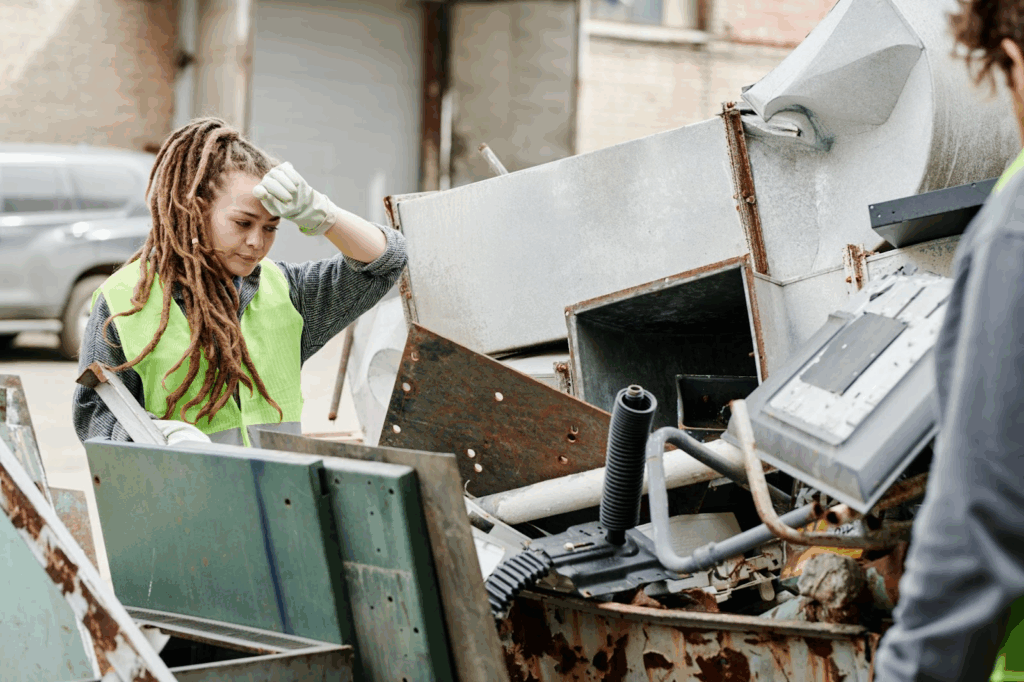Commercial buildings contain large amounts of steel, copper, and aluminum that remain valuable even after years of use. When renovations, demolitions, or upgrades occur, these metals are often left behind as waste. If not removed safely, they create risks to workers, tenants, and the surrounding environment. Responsible recovery turns potential hazards into assets that support business growth.
Why Recycled Metal Matters in Commercial Buildings
Recycled metal in commercial properties holds both financial and safety value. When businesses fail to manage it correctly, they risk missing economic opportunities while exposing people to harm. Proper recovery ensures that metals are reused instead of being wasted, reducing landfill demand. That makes safe removal a central part of commercial building management.
Common Sources of Recycled Metal in Buildings
Metals are found in HVAC systems, electrical wiring, beams, roofing, and plumbing. Renovations often release large volumes of these materials, making them highly visible during projects. Copper wiring and aluminum panels are particularly valuable when appropriately recovered. Even lower-value steel beams contribute to overall recycling returns when collected in bulk. Identifying these sources early allows businesses to plan recovery strategies that maximize safety and financial outcomes.
Economic Value of Recovered Metals
When sold to certified recyclers, recycled metals generate steady income streams. Copper and stainless steel command premium prices, often offsetting renovation expenses. Businesses that recycle responsibly also reduce waste disposal fees, which continue to climb across regions. These financial advantages can be reinvested in building improvements or operational budgets. Recycling is a green choice and a direct way to strengthen financial stability.
The Safety Risks of Improper Metal Removal
Improper handling of recycled metals threatens people and property. Metals are heavy, sharp, and often connected to live systems, making them dangerous without proper precautions. When released into the air, soil, or water, toxic metals add further risks. Professional removal reduces these hazards and protects building operations.
Hazards of Sharp and Heavy Metals
When handled without training, sharp metal sheets and heavy beams cause cuts, crush injuries, and strain-related accidents. When rusted or corroded metal introduces infections after minor wounds, workers face added dangers. Incorrect lifting methods also lead to long-term musculoskeletal issues that impact labor health. Without protective gear, these risks grow even higher during demolition or renovation work. Professional crews use safe lifting equipment and wear protective clothing to reduce exposure. Preventing injuries protects both workers and businesses from costly claims.
Fire and Electrical Hazards
Electrical wires left connected to live circuits are one of the most dangerous risks during metal removal. A single spark can trigger fires, particularly when cutting tools interact with flammable surroundings. Metals conduct electricity, meaning one mistake can cause severe shocks or burns. Cutting torches and grinders also generate heat that spreads fire quickly if safety protocols are ignored. Certified crews deactivate circuits before cutting and monitor flammable areas with fire-resistant equipment. These steps make removal safer and prevent building damage.
Toxic Metals and Environmental Impact
Many commercial properties still contain hazardous metals such as lead, mercury, or asbestos-wrapped ducts. When disturbed, these materials release contaminants that spread through soil, water, and air. The result is expensive cleanup costs alongside public health risks. Businesses responsible for these incidents may face environmental fines and legal challenges. Certified recycling teams follow strict procedures to contain and remove toxic metals safely. Their work not only protects the environment but also shields companies from liability.

Professional Methods for Safe Recycled Metal Removal
Professional removal contractors use proven methods to recover metals safely while protecting workers and structures. Their approach combines site planning, advanced tools, and certified recycling practices. By managing risks, they also preserve the value of recyclable materials. These methods deliver efficient results without cutting safety corners.
Site Assessments Before Metal Removal
A professional project begins with a thorough site inspection that identifies risks. Contractors check whether metals form part of structural supports or active electrical systems. The inspection also reveals hidden dangers such as toxic materials or unstable frameworks. With this information, contractors design a removal plan that minimizes building damage. Assessments also determine how metals will be separated and stored for recycling. This planning step saves both time and money during the project.
Tools and Techniques Used by Experts
Removal teams use specialized tools like cranes, shears, and cutting torches for precision. In volatile environments, they switch to non-sparking tools to reduce ignition risks. Magnetic separators and sorters help organize ferrous and non-ferrous metals for transport. To stay safe, workers wear protective equipment such as helmets, gloves, and respirators. Advanced machinery improves efficiency and raises the value of metals by avoiding contamination. These combined methods create a controlled and effective removal process.
Recycling and Transportation Practices
Metals are carefully sorted on-site to maintain purity and maximize resale value. Once organized, they are loaded securely onto trucks that comply with local transport regulations. Transporting metals safely prevents spills, theft, or loss during the journey. Certified recycling facilities then process these materials into reusable forms. Documentation is provided at each stage, proving compliance with regulations and reinforcing accountability. These practices close the loop and guarantee that metals reenter the market responsibly.
Training and Certification of Workers
Workers receive specialized training in safety protocols, hazardous material handling, and machinery operation. Certifications confirm that crews can manage complex projects without risking accidents. Ongoing training keeps workers updated on changing regulations and industry practices. Experienced teams also complete jobs faster and more efficiently, reducing businesses’ downtime. Employers who hire certified professionals minimize liability and protect employees on-site. This commitment to training creates safer, more reliable outcomes for all parties involved.
Compliance and Legal Responsibility in Metal Removal
Business owners remain legally accountable for how metals are removed and recycled. Even with contractors on-site, owners face fines or lawsuits if regulations are ignored. Authorities monitor projects closely to prevent unsafe practices. Following established rules reduces risk while keeping projects on schedule.
Local and Federal Waste Regulations
Waste regulations vary but consistently prioritize worker safety and environmental protection. OSHA requires strict safety measures during demolition and removal work. The EPA regulates the disposal of hazardous building materials like lead and mercury. Local governments often demand permits before transporting large volumes of scrap. Failure to follow these rules can result in fines, penalties, or even project shutdowns. Understanding the legal framework is crucial before removal begins.

Liability Risks for Business Owners
Owners who neglect safe removal expose themselves to expensive legal challenges. If workers suffer injuries, liability claims target the property owner and the contractor. Environmental damage from improper disposal leads to heavy penalties and reputation loss. Hiring uncertified contractors makes these risks even greater. Documenting every stage of removal provides a strong legal defense. Responsible oversight is the best protection against liability.
Benefits of Safe Recycled Metal Recovery for Businesses
Safe recycling practices provide advantages that extend beyond waste management. Businesses gain financial returns, sustainability credibility, and operational improvements. These benefits shape long-term outcomes that support growth and trust. Treating recycled metals responsibly positions companies as both safe and forward-thinking.
Financial Advantages of Responsible Recycling
Recycling metals offsets costs tied to renovation or demolition projects. High-value metals like copper generate reliable revenue streams when sold. Businesses also save on landfill fees, which continue to rise across regions. Tax incentives may further reward companies that document sustainable practices. Each of these benefits adds measurable financial relief. Together, they make recycling a profitable business decision.
Supporting Sustainability and Brand Reputation
Recycling metals helps companies demonstrate real progress in sustainability. Reports highlighting safe practices strengthen investor and tenant confidence. Clients increasingly prefer to work with businesses that reduce their environmental footprint. Recycling aligns brand identity with green practices, boosting reputation in competitive markets. A commitment to recycling also appeals to employees who value sustainable workplaces. These combined factors make recycling a public and internal advantage.
Long-Term Operational Benefits
Safe removal eliminates hidden hazards that may disrupt future projects. Clean building sites reduce contamination risks during upgrades or expansions. Removing outdated metals lowers maintenance costs linked to corrosion or leaks. Businesses avoid delays when future contractors encounter fewer obstacles. Proper recycling also reduces risks tied to regulatory compliance in later projects. Over time, these benefits protect operations and reduce unnecessary expenses.
Contribution to the Circular Economy
Metal recycling directly supports a circular economy where resources are reused. Instead of mining fresh ores, industries reuse recovered materials, reducing strain on natural resources and cutting carbon emissions. Businesses that recycle contribute to these broader environmental goals. In turn, they also align with global and local sustainability targets. Recycling, therefore, creates both local and international impact.
Safe Recycled Metal Removal as a Business Priority
Metals continue to accumulate in commercial buildings through daily operations and renovations. Delaying their removal increases both safety and financial risks. Regulations are tightening, making non-compliance more costly than ever. Addressing metal recovery now prevents complications later.
Why Delaying Metal Removal Costs More
When metals remain unused, they corrode and lose recycling value. Thieves target scrap metals like copper, creating additional replacement costs. Environmental regulators impose stricter penalties on unsafe disposal each year. Businesses also face greater cleanup expenses if metals spread contamination. Each delay increases costs that outweigh the value of safe recycling. Acting quickly protects both financial and legal standing.
Moving Forward With Safe Recycling Practices
The first step toward safe recycling is arranging a professional assessment. Contractors then create a clear plan that outlines safety protocols and recovery goals. Certified teams execute removal while documenting each stage for compliance. Metals are transported securely to recycling facilities for processing. This process creates accountability and guarantees metals reenter the supply chain responsibly. Businesses that adopt this approach protect their assets while supporting sustainability.
Drive Growth Through Safe Recycled Metal Recovery
Recycled metal in commercial buildings is not just debris waiting for disposal—it is a resource with financial, safety, and environmental impact. Businesses that manage it responsibly reduce risks while unlocking new opportunities for efficiency and sustainability. Each project handled with care strengthens credibility and long-term value. Choosing safe metal recovery is a direct step toward driving growth and building trust in every aspect of operations.
Turn recycled metal recovery into a strategy, not a waste. The Top Dog Waste Solutions blog offers practical resources.








